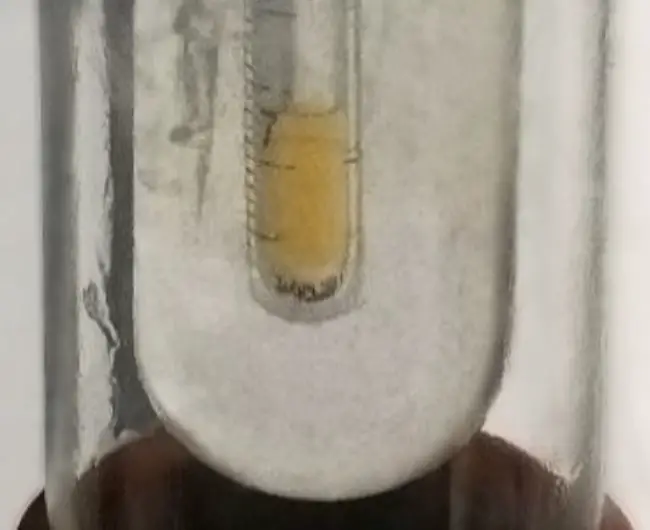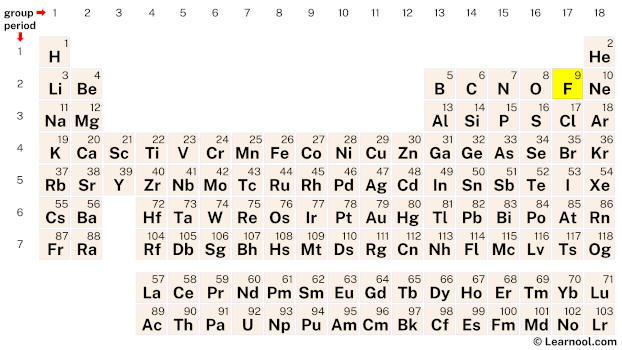
Fluorine (F) is a chemical element of the periodic table, located in the group 17 and the period 2, and is having the atomic number 9. It is a pale yellow or green gas, whose name comes from the Latin word “fluere”, which means to flow. It is a reactive nonmetal and is the 13th most abundant element on earth. It is the most electronegative element. It is the first element in the halogen group and is the lightest halogen.
On periodic table
| group | ⇨ | 1 | 2 | 3 | 4 | 5 | 6 | 7 | 8 | 9 | 10 | 11 | 12 | 13 | 14 | 15 | 16 | 17 | 18 |
| period | ⇩ | ||||||||||||||||||
| 1 | 1 H  Hydrogen |
2 He  Helium |
|||||||||||||||||
| 2 | 3 Li  Lithium |
4 Be  Beryllium |
5 B  Boron |
6 C  Carbon |
7 N  Nitrogen |
8 O  Oxygen |
9 F Fluorine |
10 Ne  Neon |
|||||||||||
| 3 | 11 Na  Sodium |
12 Mg  Magnesium |
13 Al  Aluminium |
14 Si Silicon |
15 P  Phosphorus |
16 S  Sulfur |
17 Cl  Chlorine |
18 Ar  Argon |
|||||||||||
| 4 | 19 K  Potassium |
20 Ca  Calcium |
21 Sc  Scandium |
22 Ti  Titanium |
23 V  Vanadium |
24 Cr  Chromium |
25 Mn  Manganese |
26 Fe  Iron |
27 Co  Cobalt |
28 Ni  Nickel |
29 Cu  Copper |
30 Zn  Zinc |
31 Ga  Gallium |
32 Ge  Germanium |
33 As  Arsenic |
34 Se  Selenium |
35 Br  Bromine |
36 Kr  Krypton |
|
| 5 | 37 Rb  Rubidium |
38 Sr  Strontium |
39 Y  Yttrium |
40 Zr  Zirconium |
41 Nb  Niobium |
42 Mo  Molybdenum |
43 Tc  Technetium |
44 Ru  Ruthenium |
45 Rh  Rhodium |
46 Pd  Palladium |
47 Ag  Silver |
48 Cd  Cadmium |
49 In  Indium |
50 Sn  Tin |
51 Sb  Antimony |
52 Te  Tellurium |
53 I  Iodine |
54 Xe  Xenon |
|
| 6 | 55 Cs  Caesium |
56 Ba  Barium |
72 Hf  Hafnium |
73 Ta  Tantalum |
74 W  Tungsten |
75 Re  Rhenium |
76 Os  Osmium |
77 Ir  Iridium |
78 Pt  Platinum |
79 Au  Gold |
80 Hg  Mercury |
81 Tl  Thallium |
82 Pb  Lead |
83 Bi  Bismuth |
84 Po  Polonium |
85 At  Astatine |
86 Rn  Radon |
||
| 7 | 87 Fr  Francium |
88 Ra  Radium |
104 Rf  Rutherfordium |
105 Db  Dubnium |
106 Sg  Seaborgium |
107 Bh  Bohrium |
108 Hs  Hassium |
109 Mt  Meitnerium |
110 Ds  Darmstadtium |
111 Rg  Roentgenium |
112 Cn  Copernicium |
113 Nh  Nihonium |
114 Fl  Flerovium |
115 Mc  Moscovium |
116 Lv  Livermorium |
117 Ts  Tennessine |
118 Og  Oganesson |
||
| 57 La  Lanthanum |
58 Ce  Cerium |
59 Pr  Praseodymium |
60 Nd  Neodymium |
61 Pm  Promethium |
62 Sm  Samarium |
63 Eu  Europium |
64 Gd  Gadolinium |
65 Tb  Terbium |
66 Dy  Dysprosium |
67 Ho  Holmium |
68 Er  Erbium |
69 Tm  Thulium |
70 Yb  Ytterbium |
71 Lu  Lutetium |
|||||
| 89 Ac  Actinium |
90 Th  Thorium |
91 Pa  Protactinium |
92 U  Uranium |
93 Np  Neptunium |
94 Pu  Plutonium |
95 Am  Americium |
96 Cm  Curium |
97 Bk  Berkelium |
98 Cf  Californium |
99 Es  Einsteinium |
100 Fm  Fermium |
101 Md  Mendelevium |
102 No  Nobelium |
103 Lr  Lawrencium |
|||||
| – p block |
Fluorine is a p-block element, situated in the seventeenth column and the second row of the periodic table. Its atomic number is 9 and its symbol is F.
Element information
 |
|
 |
|
| Origin of name | Latin word “fluere” (which means to flow) |
| Symbol | F |
| Atomic number (Z) | 9 |
| Atomic mass | 18.998403 u |
| Block | p-block |
| Group | 17 (halogen) |
| Period | 2 |
| Classification | Reactive nonmetal |
| Covalent radius | 64 pm |
| Van der Waals radius | 135 pm |
| Melting point | -219.67 ℃, -363.41 ℉, 53.48 K |
| Boiling point | -188.11 ℃, -306.60 ℉, 85.03 K |
| Electron configuration | [He] 2s2 2p5 |
| Electrons per shell | 2, 7 |
| Learn how to draw: Fluorine Bohr model | |
| Crystal structure | Cubic |
| Phase at r.t | Gas |
| Density near r.t | 1.696 g/L |
| Main isotopes | Fluorine-19 |
| Natural occurrence | Primordial |
| Oxidation state | -1 |
| Electronegativity (Pauling scale) | 3.98 |
| Protons Neutrons Electrons |
9 10 9 |
| Learn how to find: Fluorine protons neutrons electrons | |
| Valence electrons | 7 |
| Learn how to find: Fluorine valence electrons | |
| CAS number | 7782-41-4 |
| Discovered by | André-Marie Ampère in 1810 |
History

Fluorine has a rich and fascinating history that dates back centuries. The earliest mention of the element comes from Georgius Agricola in 1529, who described fluorite as a substance that could lower the melting point of metals during smelting. Agricola coined the term “fluorēs” for fluorite rocks, which eventually evolved into “fluorspar” and “fluorite.” It wasn’t until later that the composition of fluorite was discovered to be calcium difluoride.
In the 18th century, Andreas Sigismund Marggraf and Carl Wilhelm Scheele both independently experimented with fluorite, ultimately leading to the discovery of hydrofluoric acid. Marggraf characterized hydrofluoric acid in 1764, while Scheele named the acidic product “fluss-spats-syran” (fluorspar acid) in 1771. In 1810, the French physicist André-Marie Ampère suggested the name “fluorine” for the element, which was later adopted in most European languages. Ampère also proposed that fluorine was an element analogous to chlorine and hydrogen, which was later proven to be true.
Despite early experiments with hydrofluoric acid being dangerous and often resulting in accidents, chemists persisted in their quest to isolate elemental fluorine. Edmond Frémy postulated that electrolysis of pure hydrogen fluoride could generate fluorine, but this was later disproved by Henri Moissan. Moissan found that a mixture of potassium bifluoride and dry hydrogen fluoride was a conductor, enabling him to finally isolate elemental fluorine in 1886 after years of trial and error. Large-scale production of fluorine began during World War Ⅱ for various military and industrial purposes, ultimately driving the post-war development of fluorochemicals.
Occurrence
Fluorine is the 13th most abundant element in the Earth’s crust, occurring naturally in various minerals such as fluorite, cryolite, topaz, and apatite. However, it is not found in its free elemental form due to its highly reactive nature. Fluorine can also be found in trace amounts in seawater, rocks, and soils. In fact, it is estimated that the Earth’s crust contains about 600 to 700 ppm (parts per million) of fluorine, making it more abundant than lead, silver, or mercury.
Fluorine-containing minerals are primarily found in countries such as China, Mexico, South Africa, Russia, and Spain. The most common fluorine mineral is fluorite, which is composed of calcium fluoride (CaF2) and is often used as a source of fluorine for various industries. Cryolite, another important fluorine mineral, is primarily found in Greenland and was historically used in the production of aluminum.
Production
The production of elemental fluorine is typically carried out by the electrolysis of hydrogen fluoride (HF) in a solution of potassium bifluoride (KHF2) or anhydrous hydrogen fluoride. This process is similar to the production of aluminum using the Hall-Héroult process. The electrolysis of hydrogen fluoride generates fluorine gas at the anode and hydrogen gas at the cathode.
Another method for producing fluorine is the thermal decomposition of various fluorine-containing compounds such as fluorite or fluorspar. This process involves heating the mineral to a high temperature, which causes it to release fluorine gas. However, this method is less common than electrolysis due to its higher cost and lower efficiency.
In addition to these methods, there are also some novel methods being developed for producing fluorine, such as the use of plasma technology or supercritical fluids. However, these methods are still in the experimental stage and have not yet been commercialized.
Properties
Physical properties
Fluorine is the most electronegative element, which means it has a very strong attraction for electrons.
It is the lightest halogen, with an atomic weight of 18.9984 u.
It has a melting point of -219.67 ℃ and a boiling point of -188.11 ℃.
Fluorine is a diatomic molecule, meaning that it consists of two atoms bonded together.
Chemical properties
Fluorine is extremely reactive and will readily react with almost all other elements to form compounds.
It is the most oxidizing element, meaning it has the highest tendency to gain electrons and form negative ions.
Fluorine can displace oxygen from water, producing hydrogen fluoride gas and ozone.
It can also react explosively with hydrogen and other organic compounds.
Other properties
Fluorine has a very small atomic radius, which allows it to form strong bonds with other atoms.
It is the only element that can form compounds with noble gases.
Fluorine has a very high bond dissociation energy, meaning it requires a large amount of energy to break the bonds between its atoms.
Health and safety properties
Fluorine gas is extremely toxic and can cause severe burns and lung damage.
Exposure to low concentrations of fluorine can cause eye and respiratory irritation, while exposure to high concentrations can be fatal.
Fluorine is an essential element for dental health, as it can help prevent tooth decay. However, excessive fluoride intake can lead to dental fluorosis and other health problems.
Applications
Fluorine is used as a feedstock for the production of a range of fluorine-containing compounds, including hydrofluoric acid, chlorofluorocarbons (CFCs), and fluoropolymers. Hydrofluoric acid is used to etch glass, while CFCs and fluoropolymers have various industrial uses.
Fluorine compounds are used in the production of a range of medicines, including antibiotics, antiviral drugs, and anticancer agents. Fluorine is also used in the production of contrast agents used in medical imaging.
Fluorine is widely used in the production of a range of electronic components, including computer chips and liquid crystal displays (LCDs). Fluorine-containing compounds are used in the cleaning of these components during manufacturing.
Fluorine is used in the production of high-performance materials, such as Teflon, which is a popular non-stick coating used in cookware. Other fluorine-containing materials include Gore-Tex, which is used in outdoor clothing to provide waterproof and breathable properties.
Fluorine is used as a rocket propellant due to its high energy density. It is also used in the production of high-performance polymers used in aerospace applications.
Fluorine is used in the nuclear industry to separate isotopes of uranium, and as a coolant in some nuclear reactors.
Fluorine is also used in the production of dental products, including fluoride-containing toothpaste and mouthwash, which help to prevent tooth decay.
Interesting facts
Fluorine is the most reactive and electronegative element on the periodic table, and it can even react with noble gases under certain conditions.
Fluorine gas has a pale yellow color and is highly toxic, which is why it is never found in its pure form in nature.
Fluorine has the highest electron affinity of all elements, which means it has a strong attraction for electrons and can form stable ionic compounds with other elements.
Fluorine is used in many industrial applications, including in the production of aluminum, uranium, and refrigerants, as well as in dental products such as toothpaste and mouthwash.
The use of fluorine in toothpaste and water fluoridation has been credited with significantly reducing tooth decay and improving oral health.
Fluorine has only one stable isotope, fluorine-19, but several radioactive isotopes have been produced for research purposes.
Despite its highly reactive nature, fluorine is still an essential element for life and is found in small amounts in the human body, where it is important for healthy bones and teeth.
Related
More elements
External links
- https://www.rsc.org/periodic-table/element/9/fluorine
- https://en.wikipedia.org/wiki/Fluorine
- https://www.britannica.com/science/fluorine
- https://pubchem.ncbi.nlm.nih.gov/element/Fluorine
- https://education.jlab.org/itselemental/ele009.html
- https://www.chemicool.com/elements/fluorine.html
- https://www.livescience.com/28779-fluorine.html
Deep
Learnool.com was founded by Deep Rana, who is a mechanical engineer by profession and a blogger by passion. He has a good conceptual knowledge on different educational topics and he provides the same on this website. He loves to learn something new everyday and believes that the best utilization of free time is developing a new skill.
